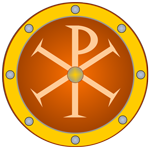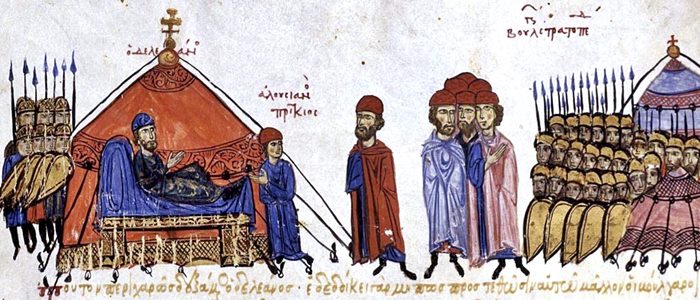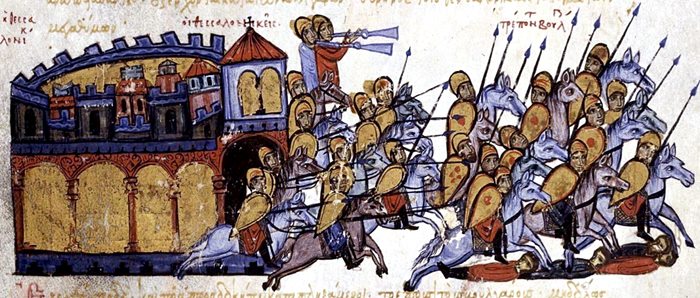
Battle of Thessalonica |
year: 1040October 1040 |
| Defeat of a Bulgarian army besieging Thessalonica | ★ ★ ★ ★ ★ |
|
enemy: Bulgarians
|
location: Thessaloniki, northern Greece
|
accuracy:
●●●●●
|
|
battle type: Surprise Attack |
war: Uprisings of the Bulgarians |
modern country:
Greece |
| ▼ The Byzantines(emperor: Michael IV the Paphlagonian) | ▼ The Enemies | |
| Commander: | Governor Constantine | Alousianos (Alusian) |
| Forces: | 40,000 | |
| Losses: | 15,000 dead |
| Background story: |
| Twenty years after the end of the war with the Bulgarians, great discontent and unrest prevailed in the occupied territories, due to the appointment of a Greek archbishop in Ohrid and, also, due to the increase of taxes by the eunuch John the Orphanotrophos, the powerful éminence grise of Byzantium, in the late 1030s. In this climate of popular rage, in the spring of 1040, a fugitive named Delyan (Deleanos) appeared in Belgrade and claimed to be the son of the old Tsar Romanos (or Radomir), that is, the grandson of the great Tsar Samuel. The inhabitants of the area, who would follow anyone to get rid of the Byzantines, welcomed him and believed his story. Thus, Delyan was proclaimed tsar of the Bulgarians as Peter II (in memory of the sanctified Peter I). This was the beginning of a brief period of great unrest in the Balkans. The revolt escalated quickly due to the rage caused by the fiscal policies of Orphanotrophos. Very soon, other parts of the Balkans also sided with the insurgents. Nis, Skopje, Durres. The Greeks who happened to be on their way were slaughtered. Delyan besieged Thessaloniki, but at that point he did not have the means for an effective siege, and left heading south. In Boeotia, the Bulgarians defeated the general of the Thema of Greece, Allacaseas, and then looted and destroyed Thebes, slaughtering a large number of civilians. So within a few months, out of nowhere, Delyan prevailed over a large area stretching from present-day Serbia to Corinth, controlling western and central Macedonia, and also present-day Albania and Epirus. Things did not look good for the empire, which at the time was losing ground on all other fronts. Unexpectedly, the situation was saved for the Byzantines by an internal rival of Delyan:  Alousianos meets Delyan in Ostrovo Alousianos after the capitulation of 1018, had found himself in Byzantium, where over the years had taken high positions. He had been strategos of Theodosioupolis in Asia Minor (Erzerum), but lately, having been slandered, he had fallen into disfavor. In addition, Orphanotrophos forced him to pay, for his alleged crime, 50 pounds of gold and took from him a fief in Cappadocia. Obviously the demotivated Alousianos had good reasons to join the hitherto successful uprising of his compatriots. After all, he was their rightful leader. Peter II Delyan received Alousianos well and knowing that no one believed that he (Delyan) was a descendant of the royal family, made Alousianos co-tsar. Now the Bulgarians had two kings. |
The Battle: |
 the defeat of the Bulgarians in the Skylitzes manuscript The lord of the city was patrikios Constantine, nephew of Emperor Michael IV, who diligently prepared for the siege and dug a trench around the city walls. The siege lasted 6 days. The Bulgarians were many, and this time they had come equipped with catapults and siege engines; but their attacks were easily repulsed. On the night of the last day, the defenders of the city prayed all night in the tomb of Agios Dimitrios and in the morning opened the gates and attacked the besiegers. What the Bulgarians probably did not know was that the garrison of Thessaloniki was reinforced with a unit of the formidable Varangian guard (described in this case as τάγμα Μεγαθύμων – battalion of the enraged). The Bulgarians were taken by surprise and unprepared to defend themselves, they were devastated. Their losses were unbelievable for the scale of the conflict: 15,000 dead. The rest of the Bulgarians fled and Alousianos returned humiliated to Ostrovo. He now had reason to fear that Delyan would get rid of him. According to Skylitzes, the Bulgarian captives attributed their defeat to the intervention of the patron saint of Thessaloniki, Agios Dimitrios, who led the Byzantine attack. Everyone was talking about an unknown young man on a horse leading the attack and throwing fire at the enemies who were paralyzed. There is some truth in this story because in the battle, most probably, took part the legendary leader of the Varangian guard Harald Hartrada. |
Noteworthy: |
| According to a theory, Alousianus was from the beginning a mole of the Byzantines, who sent him to Delyan to undermine the uprising. This explains a lot: the blinding of Delyan, the surrender without a reason to the Byzantines when he became tsar and how easily he was received back with honors in Constantinople. This is a logical assumption, but the sources do not provide sufficient information about the actual events and Alousianos’ real motives. |
Aftermath: |
| A few months later, in 1041, during a dinner party, Alousianos attacked the drunken Delyan and with a kitchen knife cut off his nose and blinded him. So he was left alone on the throne. However, he very quickly surrendered to Byzantium, where he reclaimed his property and was awarded the title of magistros. The blind Peter Delyan regained the leadership, but Michael IV himself campaigned against him and easily defeated the Bulgarians in Ostrovo. The uprising of Delyan ended there. |
|
|
